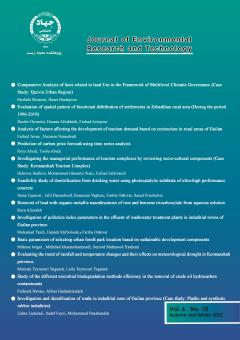Evaluation of trend of rainfall and temperature changes and their effects on meteorological drought in Kermanshah province
Subject Areas : natural geographyMaryam Teymouri Yeganeh 1 , Liela Teymouri Yeganeh 2
1 - Razi university
2 - Yazd university
Keywords: Drought, Temperature and rainfall changes, Mann-Kendall test, Sense estimator, Linear regression, Kermanshah province ,
Abstract :
Climate change is one of the natural features of the atmospheric cycle, which results in anomalies or fluctuations in the process of meteorological parameters such as rainfall and temperature. Also, drought is one of the weather and climate disasters, including catastrophic events. It alternates with floods and causes significant damage each year. Lack of rainfall has different effects on groundwater, soil moisture and river flow. For this reason, the study of changes in precipitation and temperature has always been the focus of researchers in various sciences, including natural resources and the environment. In this study, using the data of Kermanshah Meteorological Organization related to 30 years of rainfall, average minimum temperature and average maximum temperature in three stations of Kermanshah, Islamabad West and Sarpol-e Zahab to assess the severity of drought each year by DIC software Using standard precipitation index (SPI) and examining the trend of temperature changes using two non-parametric Mann-Kendall tests, Sensitimator and also linear regression. In order to study the drought trend during the 30-year period, statistical software was used and the results showed that during the 30-year period, all three stations are in near normal condition. Also, the results of temperature changes using the mentioned tests indicate the increasing trend of temperature and this trend is significant at the level of 99% using two non-parametric Mann-Kendall tests.
1. تیموری یگانه، ل. تیموری یگانه، م. (1399). کاربرد مدل سری زمانی برای تخمین میزان بارش ماهانه در استان کرمانشاه. نشریه پژوهش¬های اقلیم شناسی. سال یازدهم، شماره44، صص 142-137.
2. جهانگیر، م.ح.، خوش مشربان، م.، یوسفی، ح. (1394). پایش و پیش بینی وضعیت خشکسالی با استفاده از شاخص بارندگی استاندارد (SPI) و شبکه عصبی پرسپترون چند لایه (مطالعه موردی: استان¬های تهران و البرز). مجله اکوهیدرولوژی. دوره 2، شماره 4.
3. حجازی زاده، ز.، جوئی زاده ، س. (1389). آشنایی با خشکسالی و شاخص های آن. انتشارات سمت ، ص 358.
4. حجانی، س.، بذر افشان، ج. (1394). مقایسه دو رهیافت محاسبه شاخص بارندگی استاندارد در اقلیم¬های خشک و مرطوب ایران. مجله علوم و مهندسی آبخیزداری ایران. دوره 9، شماره 28، صص 64-61.
5. شمس نیا، ا. (1386). تعیین طبقه بندی بهینه شاخص استاندارد شده بارش(SPI) در ارزیابی خشکسالی¬های استان فارس. سمینار کارشناسی ارشد، دانشگاه آزاد اسلامی واحد فیروز آباد، 48 صفحه.
6. فرحزاده،م.، موحد دانش، ع.1.، قائمی، ه. ( 1369). خشکسالی در ایران(با استفاده از برخی شاخص¬های آماری). دانش کشاورزی 5(1و2): 52-30.
7. مقدم، ح.، بداق جمالی، ج.، جوانمرد، س. مهدویان، ع، ل. خزانه داری، م. خسروی،م. ابراهیم پور. (1380). پایش خشکسالی براساس نمایه SPI ، دهک¬ها و نرمال در استان سیستان و بلوچستان. مجموعه مقالات اولین کنفرانس بررسی راهکارهای مقابله با بحران آب، دانشگاه زابل، 80-69.
8. Chang, T.J.(1989). Characteristics of extreme precipitations. Water resour. Bull. 25(5):1037-1040.
9. Diaz, H.F. (1983). Som aspects of major dry and wet periods in the contiguous united states,1895-1981.j.climate appl. Meteorol.22:2-16.
10. Guttman, N. B. (1999). Accepting the standardizedized precipitation index: A calculation algorithm. Journal of American water Resources Association 35(2): 311-322.
11. Herbst,P.H.,D.B. bredencamp and H.M.G. baker.(1966). a technique for the evaluation of drought from rainfall data. J.hydrol. 4(4):264-272.
12. Kendall, M. (1975). Rank Correlation Methods, Griffin, London.
13. Mann, H. B. (1945). Nonparametric tests against trend. Econometrica. 13:245-259.
14. Mckee, T. B., N. J. Doesken and J. kleist. (1993). The relationship of drought frequency and duration to time scales. Preprints, 8th Conference on Applied Climatology, 17-22 January,Anaheim, CA, 170-184.
15. Mohan,S. and N.C. rangacharia. (1991). A modified method for drought identification. Hydrol.Sci.J.
16. Palmer, W. C. (1965). Meteorological drought. U.S. Department of commerce Weather, Bureau Reasearch Paper 45, 58pp.
17. Serrano, S. M. and J. I. Moreno. (2005). Hyrological response to different time scales of climatological drought: An evaluation of the standardized precipitation index in a mountainous mediterranean basin. Hydrology and Earth System Sciences Discussions 2:1221-1246.
18. Shafer, B. A. and L. E. Dezman. (1982). Development of a surface water supply index (SWSI) to assess the severity of drought conditions in snow pack runoff areas. Proceedings of The Western Snow Conference pp: 164-175.


